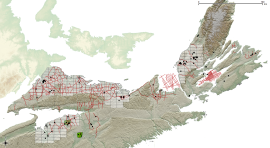Opening data in Nova Scotia
/ When it comes to data, open doesn't mean part of the public relations campaign. Open must be put to work. And making open data work can take a lot of work, by a number of contributors across organizations.
When it comes to data, open doesn't mean part of the public relations campaign. Open must be put to work. And making open data work can take a lot of work, by a number of contributors across organizations.
Also, open data should be accesible by more than the privileged few in the right location at the right time, or with the right connections. The better way to connect is by digital data stewardship.
I will be speaking about the state of the onshore Nova Scotia petroleum database Nova Scotia Energy R&D Forum in Halifax on 16 & 17 May, and the direction this might head for the collective benefit of regulators, researchers, explorationists, and the general public. Here's the abstract for the talk:
Improving the accessibility of the province's onshore
subsurface database: a user-driven approach
Evan Bianco & Matt Hall
The federal Program for Energy Research and Development (PERD) is identifying areas in eastern Canada worthy of future research into source-rock plays. In late 2011, PERD provided the opportunity to take inventory of the province’s publicly available onshore geoscience data. The resulting data-mining exercise grew into the beginnings of an accessible, searchable, queryable, geospatial relational database. Such a resource would enable researchers and industry to explore the province’s resource opportunities more efficiently than they can today.
We have merged basic well header information for 133 petroleum wells with other digital and non-digital data. These other data include: well tops, geophysical log curves (as LAS files), core records, drilling reports, cuttings descriptions, production tests, core analysis, and Rock-Eval pyrolysis data. We have also started to integrate outcrop vitrinite reflectance data (from DNR Open File Report 91-012), cross-section illustrations, seismic line locations, gravity and aeromagnetic data, and surface geology maps.
The data are imperfect. A considerable amount of legacy data remains available only in paper format. There are also various unresolved data quality issues, even around fundamental data elements like well coordinates and elevations. There are also 69 mineral exploration wells with petroleum shows and substantial outcrop data that could potentially be included.
In order to be ‘open’, public data needs to be online, indexed, findable, understandable (human-readable), parsable (machine-readable), and multi-format. The regulatory and user communities need to collaborate to ensure our public data resources meet, and even surpass, these criteria.








 Except where noted, this content is licensed
Except where noted, this content is licensed